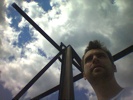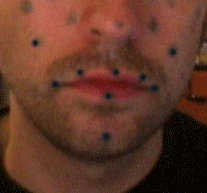So Tuesday was my first day of Graduate School. My first class was Intro to Computational Media, taught by Dan O’Sullivan. I’m very excited about this class — generically, the basic concepts of programming are taught, mainly using [Processing 1.0](http://processing.org/). Processing seems like a cool language — I’d played around with some of the examples on its website a while back. It’s sort of Java-lite; the developers have stripped down Java’s overly complex syntax to a useful minimum and made a simple environment for programming.
From the site:
>Processing is an open source programming language and environment for people who want to program images, animation, and sound. It is used by students, artists, designers, architects, researchers, and hobbyists for learning, prototyping, and production. It is created to teach fundamentals of computer programming within a visual context and to serve as a software sketchbook and professional production tool. Processing is developed by artists and designers as an alternative to commercial software tools in the same domain.
There’s a lot of visual applications as this seems to be the initial audience (check out the [examples](http://www.processing.org)), but it can be used for other things as well. And what’s cool is that the final output is Java; by the end of the semester the basic Processing syntax is peeled away to reveal its Java underpinnings, and more advanced functions can be implemented this way.
Even more important than the language and the concepts of programming, the class is about figuring out what kind of stuff you want to do with it. That’s the hard and fun part — for all the cool projects and ideas I’ve had over the years, I find myself on this first day feeling absolutely devoid of any creative spark. Which is okay — I’m sure it will come, but it’s a weird and ironic feeling now that I’m in this super creative environment.
My second class was *Applications*, which is taught by Red Burns, the department chair and founder of the program. It’s a seminar class where she invites a guest lecturer each week to present on ITP-related projects in the real world. Our first speaker was Heather Greer, an ITP alum (class of ’94 (!)) who has gone on to work as a photographer, cinematographer, filmmaker, relief-worker, installation artist, and it seems like twelve other things. Her work focuses on the connections we make with people as our reason to survive. I’ll try and find some links to her work and post them here, but suffice it to say she was an inspiring first guest as to the possibilities and opportunities that can arise from ITP’s multidisciplinary, collaborative approach.
Applications is also the only class that all incoming students take together, so it was a great opportunity to see everyone’s face and get to know some of the people I’ll be working with. We are divided into groups of five to present a response to the previous week’s speaker, so I met and enjoyed hanging out with the folks in my group. After class several of us went to Cedar Tavern for a drink, and it was amazing to sit and talk with people who were so engaged about *creative* uses of technology. With a few exceptions, I’m accustomed to people’s eyes glazing over when I start to talk about cool tech projects I’ve been seeing or thinking about — this was probably the first time I’d sat in a group of six or seven people who were all totally engaged in the discussion. Very cool.
So here’s my attempt at staying up-to-date on the blog with my ITP adventures. I have a feeling my time is going to soon vanish and blogging will once again take a back seat, but I’ll do my best to keep it fresh.






